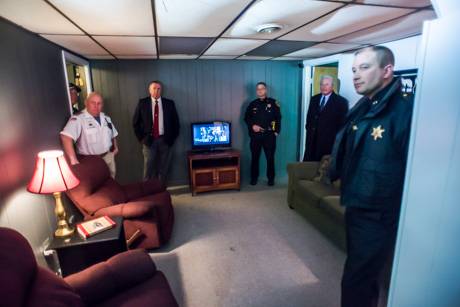
If you found an intruder in your house, would you know what to do?
Even if you were armed, would you know what to do?
Or would you panic?
Training in advance of stressful situations is key to surviving potentially hazardous conflicts and defusing them safely for yourself, your family members and even the intruder.
M&S Tactical Solutions in Batavia has set up an Active Home Invasion System at its facility in the Harvester Center in Batavia.
It's designed to provide training for the company's primary clients, local residents who want to improve security in their home, especially if they keep a firearm.
Yesterday, Sheriff William Sheron and members of his command staff -- Greg Walker, Jerry Brewster, Bill Zipfel, and Joe Graff -- toured the new facility (along with Mercy medic Wade Schwab) and Zipfel and Graff both went through simulated home invasion scenarios to experience how the training works.
"I like it because it’s realistic," Zipfel said. "It's not like our tower. There’s actual furniture. It’s really nice."
While the AHIS is set up to train civilians, it's also used by local police officers to get extra training and practice in detecting and reacting to threats in real-life scenarios.
Participants, if armed, are armed with realistic-looking airsoft pistols and wear face masks.
When it's civilians going through, they are given a basic firearm safety course, even if previously trained, just to make sure everybody is on the same page, said M&S owner Jeff McIntire. Then they're put in a scenario to see how they handle it. McIntire and his staff monitor the home invasion scenario thorugh closed circuit video so they can review how things played out with the participants.
"We don’t give them anything at first," McIntire said. "We put them over there because we want to see what your natural reaction is. I want to see what you naturally do. Then we come back here and debrief. Now we can start actually talking about what to do."
One recent participant fired first and asked questions later. That's a measure, McIntire said, of how realistic and stressful the scenarios can be. The adrenaline pumps and your autonomic systems take over and pushes your mind into "fight or flight" mode.
Getting past those automatic responses is what training is about. Repetition helps build up a kind of muscle memory that helps you stay calm and make better decisions.
To help teach the importance of good decision making, not all of the "intruders" are hostile. They might be an Alzheimer patient who is convinced he's in his own home, or a neighbor just knocking on your door. The intruder might even be your wife home early from work. In other words, not every scenario is hostile but could end in tragedy without proper training.
And not every intruder deserves to be shot. A TV, McIntire noted, is not worth a person's life. Participants are taught to better recognize which intruders pose a real life or limb threat to themselves or a family member.
The scenario yesterday for Graff involved the chief deputy just returning home from work. There is an intruder going through his belongings in his bedroom. At some point, the intruder comes out of the room and Graff became aware he was there. In this case, Graff drew his pistol and shouted for the intruder to put his hands where he could see them and get on the ground. As the intruder went down, he was instructed to reach for his mobile phone in his pocket. Graff yelled for him to put his hands back up and the intruder fumbled with his phone and drop it. Graff did not fire.
In the other scenario, Zipfel came home, grabbed a beer and went in the bedroom to ly down. Then two intruders entered. They began searching the living room for items and Zipfel heard the noise. He crouched down, entered the room, spotted the intruder and ordered him to the ground. As he approached the intruder, the second intruder started to enter the room from the kitchen, gun pointed at Zipfel. Zipfel shot him.
In both cases, with their boss Sheriff Sheron watching, they made the right decision.
While officers who use the facility for training aren't earning any sort of certification, McIntire said he recognizes the need for officers to get numerous repetitions of potentially dangerous situations to help improve their decision making.
Whether civilian or officer, repetition and review are key training tools for improved performance.
Without training, McIntire, people often revert to what they've seen on TV or in a movie, and that's not a good place to be.
McIntire said, "We stress getting people to that point with muscle memory where they say, 'I don't have think. I just know what to do.' "
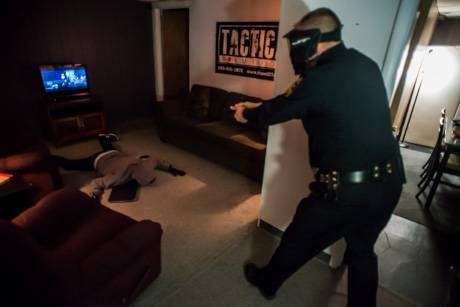
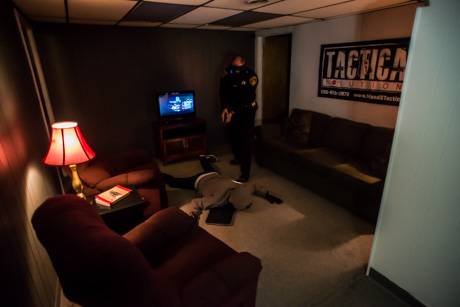
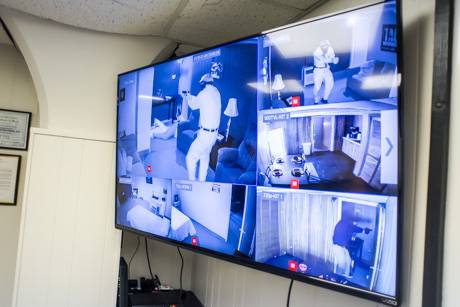
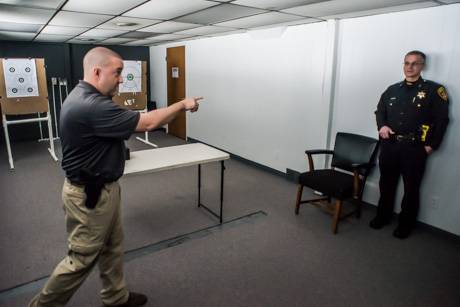
Top photo: The tour in the living room apartment. Next two photos, Graff during his scenario. Fourth photo, monitors showing Zipfel's scenario. Bottom, McIntire and Walker in the facility's firing range (where airsoft guns are used).

I plan to take this training.
I plan to take this training.
Some LEO need it also...
https://www.youtube.com/watch?v=VBUUx0jUKxc
That video led me to this one
That video led me to this one
https://www.youtube.com/watch?v=qOemQG8M7g4
Which I agree with all the way through.
Over the past two years, I've studied a bit of psychology, human behavior, and decision making. One of the things I've learned is the best way to overcome cognitive biases and build up what Jeff refers to "muscle memory" is training. Train, review, practice, and repeat. Repetitions of scenarios and review and correction, just like you learn any skill. Decision making is just another skill to learn. Just like an NFL quarterback learns through practice and experience to mentally slow down the game to improve decision making, anybody who handles a firearm in stressful situations needs to develop the ability to keep clam, process information correctly, and make better decisions. And people who do it for a living can never get too much training and practice and repetitions.
Yep Howard, I've already
Yep Howard, I've already seen, and forwarded this video on to all my friends [one is a judge, and two are police officers... and they all stand firm that the police did the right thing in this Mesa, AZ shooting]. Pretty scary.
I have my own thoughts on the
I have my own thoughts on the shooting of Daniel Shaver. The police bodycam video has been all over the Internet.
I've commented on several sites about what I thought Mr. Shaver should have done. Within 10 seconds of Mr. Shaver entering the hallway, he was lying prone on the floor, with his arms outstretched in front of him.
THAT, in my opinion, is where he should have stayed. To my way of thinking, that cop could have screamed till he was "blue in the face", but, I wouldn't have moved a muscle, once I was in that position.
I've watched too many police shootings where they claim they were "in fear for their life". In some that I've seen, I can honestly say that it could be true. But, in some, I really find it hard to believe. That's just my opinion. One need only to research the case of South Carolina Officer Michael Slager, in the shooting of Walter Scott, IN THE BACK. Read, from https://www.thedailybeast.com/michael-slager-defense-walter-scotts-felo… , where Officer "Slager took the stand on Tuesday in his own defense, testifying that he feared for his life when he shot Scott at the end of a foot chase."
Notice Officer Slager's claim that "he feared for his life when he shot Scott". When Walter Scott was 30-feet away from him, and, running away. Watch the video of Officer Slager shooting Mr. Scott in the back. As I said, yes, sometimes, I honestly believe officers are in fear for their lives. But, not always.
But, back to the shooting of Daniel Shaver. Had he stayed prone on the floor, with his arms stretched out in front of him, there's NO WAY he could have "posed a threat" to the officers. Not while he was in that position. As I said, they might yell at me for hours, but, I ain't moving from that position. If they don't find that acceptable, then, I guess they'd have to shoot me in the top of the head, because, I ain't moving! If that's what happens, then, I guess I could only hope it was caught on THEIR video.